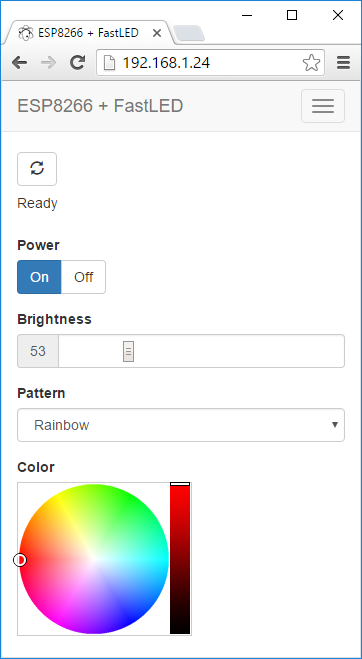Added support for dynamic fields, updated web app, etc.
FastLED + ESP8266 Web Server
Control an addressable LED strip with an ESP8266 via a web browser or infrared remote control.
Hardware
An ESP8266 development board, such as the Adafruit HUZZAH ESP8266 Breakout:
Addressable LED strip, such as the Adafruit NeoPixel Ring:
Features
- Turn the NeoPixel Ring on and off
- Adjust the brightness
- Change the display pattern
- Adjust the color
Web App
Patterns are requested by the app from the ESP8266, so as new patterns are added, they're automatically listed in the app.
The web app is stored in SPIFFS (on-board flash memory).
The web app is a single page app with separate files for js and css, using jQuery and Bootstrap. It has buttons for On/Off, a slider for brightness, a pattern selector, and a color picker (using jQuery MiniColors). Event handlers for the controls are wired up, so you don't have to click a 'Send' button after making changes. The brightness slider and the color picker use a delayed event handler, to prevent from flooding the ESP8266 web server with too many requests too quickly.
The only drawback to SPIFFS that I've found so far is uploading the files is extremely slow, requiring several minutes, regardless of how large the files are. It's so slow that I've been just developing the web app and debugging locally on my desktop (with a hard-coded IP for the ESP8266), before uploading to SPIFFS and testing on the ESP8266.
Installing
The web app needs to be uploaded to the ESP8266's SPIFFS. You can do this within the Arduino IDE after installing the Arduino ESP8266FS tool.
With ESP8266FS installed run the sketch and then upload the web app using ESP8266 Sketch Data Upload command in the Arduino Tools menu.
Compression
The web app files can be gzip compressed before uploading to SPIFFS by running the following command:
gzip -r data/
The ESP8266WebServer will automatically serve any .gz file. The file index.htm.gz will get served as index.htm, with the content-encoding header set to gzip, so the browser knows to decompress it. The ESP8266WebServer doesn't seem to like the Glyphicon fonts gzipped, though, so I decompress them with this command:
gunzip -r data/fonts/
REST Web services
The firmware implements basic RESTful web services using the ESP8266WebServer library. Current values are requested with HTTP GETs, and values are set with POSTs using query string parameters. It can run in connected or standalone access point modes.
Infrared Remote Control
Control via infrared remote control is also supported, via the ESP8266 port of the IRremote library.


